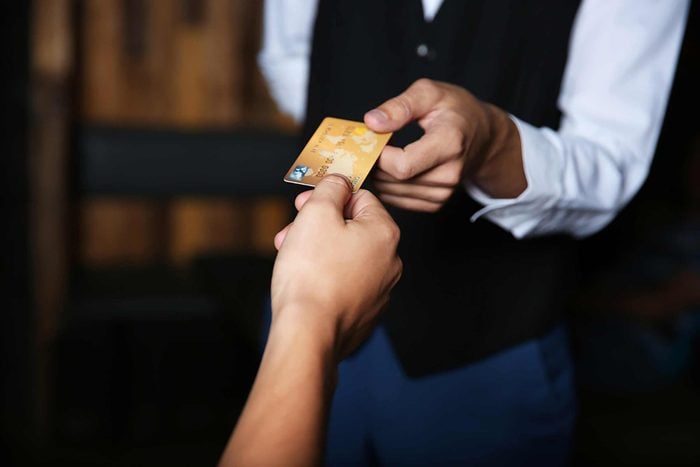
Tipping 15 percent
The old rule was to tip your server 10 percent for poor service, 15 percent for good service, and 20 percent or more for work that goes above and beyond. The times have changed, however. “The appropriate tip these days is 20 percent, minimum,” says Maryanne Parker, professional etiquette coach and author of Manor of Manners. If you have a problem with paying the tip amount or with tipping customs in general, that’s not something you should take out on your server, who counts on tips to make the majority of their pay. “Remember, frugal and cheap are two different things,” she says. Still unsure? Check out our restaurant tipping guide.

Not wearing a mask
Restaurant employees don’t have much of a choice when it comes to going into a restaurant so it would be unfair to put them at a greater risk of contracting COVID-19 because you aren’t wearing a mask or are wearing it improperly—cover your nose! It also puts them in an awkward situation when they have to enforce their mask policy out of fear of how customers may react. If you speak slowly and clearly, the restaurant employees should have no problem hearing your order. Learn more about what you shouldn’t do at reopened restaurants.
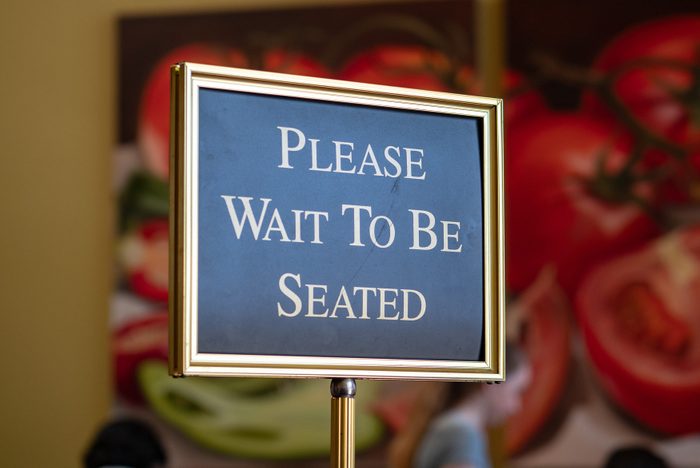
Crowding outside
Since restaurants are operating at a lower capacity right now, there may be an increased wait time for a table. While waiting, it’s important to spread out and not hover over the customers eating. This just makes people feel uncomfortable, especially when there is a greater health threat. Take a walk around the block or down the street and come back. Or you can also help the restaurant by just getting takeout.
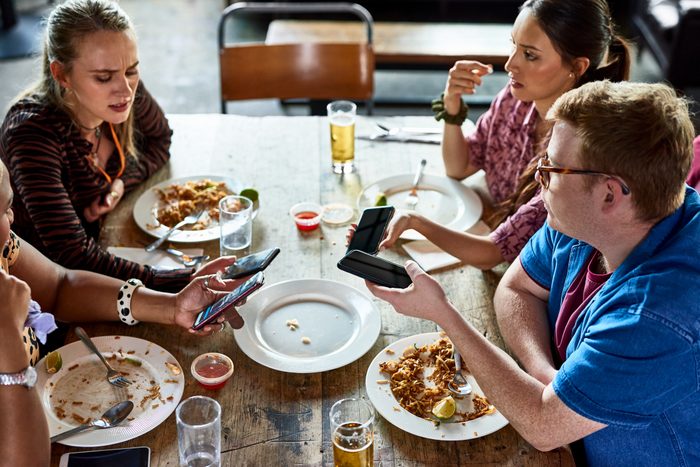
Lingering
Seating may be limited due to social distancing guidelines and restaurants are trying to operate as best as possible considering the circumstances. This isn’t the time for a long lunch. It has also been said by health experts that prolonged exposure to people with coronavirus puts people at a greater risk for contracting the illness.
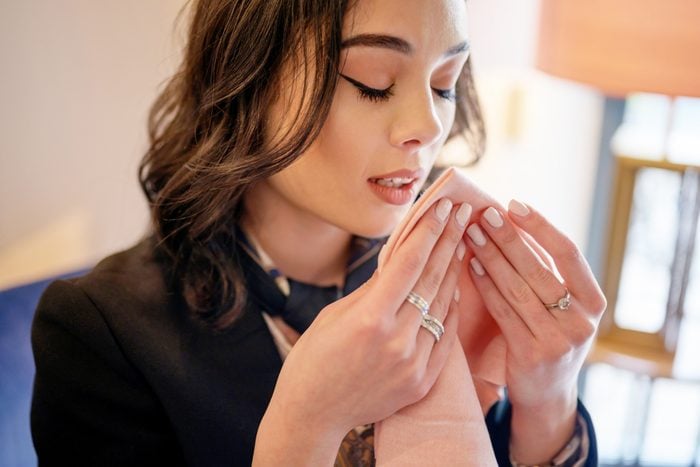
Coughing into a cloth napkin
Hopefully, most restaurants have made the switch to paper napkins during the pandemic, but in case they haven’t, cough (or sneeze) into your arm instead of the napkin. Remember that restaurant workers have to handle your garbage so by spreading your germs onto a napkin that a server has to touch, you are potentially putting them at a greater risk of getting sick. And if you do blow your nose into a paper napkin, take it with you and throw it out yourself.

Dining out while not feeling well
This should go without saying, but unfortunately, many people need to be reminded of this obvious rule. Symptoms of COVID-19 include chills, fever, cough, shortness of breath, and fatigue. Even if something feels slightly off, it’s better to be safe than sorry! Especially when it affects those around you.

Stacking plates and cups when you’re finished eating
You may be trying to be helpful to your overworked server by stacking your dirty dishes when you’re finished dining, but this is actually a breach of etiquette, says Leslie Kalk, a restaurant and hospitality coach for more than 30 years. “Stacking plates when done sends a signal to other diners that the waitstaff is not tending to the table properly and the act of doing so exposes the stackers as inexperienced diners,” she explains. “In addition, the waitstaff usually have a well-practiced system for clearing the plates, utensils, and glassware and stacking interferes with that system.” Instead, after enjoying your meal, sit back and allow the waitstaff to handle the details. After all, that’s one of the pleasures of dining out! See how your favorite restaurants might change after the coronavirus.
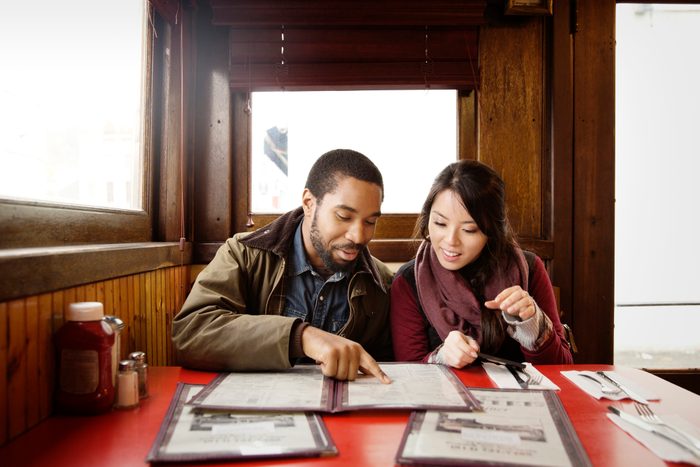
Asking for major changes to a menu item when ordering
It’s one thing to ask the kitchen to hold the tomatoes, substitute cauliflower for bread, or put your salad dressing on the side. It’s an entirely different story to ask for the barbecue spare ribs with potatoes to be made vegetarian and glazed in a garlic sauce over rice. “It’s rude to ask the kitchen to cater to an endless list of demands,” Parker says. There isn’t a hard rule for how many changes you can ask for in one dish but aim to keep it under three. If you need more changes than that, consider ordering a different dish.
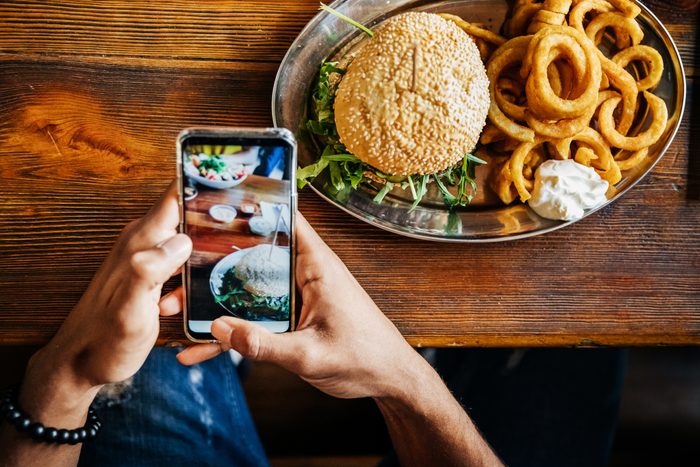
Leaving your cell phone on the table next to you
The etiquette problems with cell phones in restaurants could be their own article, but one way to short-circuit most problems is to simply turn your phone off or put it on silent and then put it out of eyesight for the duration of your stay, says Adeodata Czink, etiquette expert and author of Business of Manners. “Nothing is more irritating for others than having to listen to your notifications,” she says. “Plus it is very inconsiderate to ignore those dining with you in favor of electronic conversations. It makes them feel unimportant and ignored.” Make sure you’re abiding by these 13 little etiquette rules everyone should follow at a restaurant.

Asking waitstaff why the website isn’t working
Asking waitstaff, bartenders, or hosts about big-picture issues is not only ineffective—they’re certainly not the ones updating the restaurant’s website in their spare time—but voicing those types of concerns to them is keeping them from doing their work properly, Kalk says. “When one guest spends too much time lecturing their server on the parking situation, other guests are not getting their drinks or their food delivered to their table,” she says. “Instead, ask yourself if the complaint you’re about to share is one for which they might have a solution or be able to make a change. If not, ask for the email address of a manager, owner, or executive who can address your concern.” Don’t miss these secrets your restaurant server isn’t telling you.

Ordering dishes off-menu
Another major faux pas is when people try to create a dish that’s not on the menu, Parker says. The menu is there for a reason and the chef has put a lot of care into creating the dishes. The kitchen is there to serve you but not to create and cook a bespoke meal from scratch just for you, she explains. If you’re not sure if a restaurant will be able to accommodate your specific dietary needs, or if you’d like to request something time-consuming, it’s best to call ahead and ask if that’s something they can do. And be sure to be extra generous with your tip afterward.

Men ordering before ladies
“Men ordering before ladies may not seem like an important modern issue, but restaurants are still enclaves of ritual, etiquette, and chivalry, and ignoring that just drags our society further into mayhem and even chaos,” Kalk says. Men should always allow the ladies at the table the right of first refusal when placing orders. “If they aren’t ready then you can go ahead and order,” she says. Rules can vary by culture, however, like these 13 strange etiquette rules around the world.
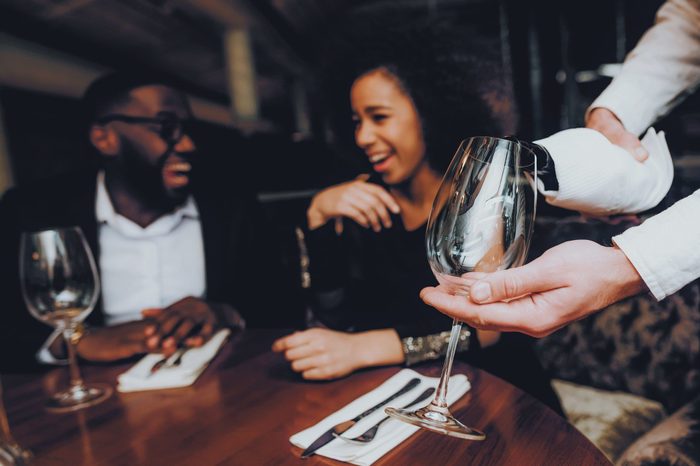
Stealing your neighbor’s wine glass
The nicer the restaurant, the more utensils, cups, and dishes you have to deal with. It can get overwhelming very quickly which can lead people to accidentally take something meant for someone else, Parker says. Fortunately, there’s a quick way to figure out what’s yours, she says. “Follow the simple BMW rule: From left to right, your place setting is Bread, Main course, then Water or wine,” she explains. “You’ll never end up drinking out of someone else’s glass again!”
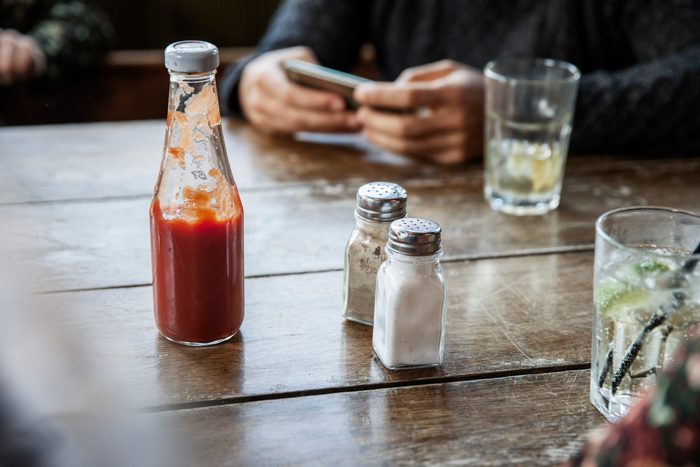
Separating the salt and pepper shakers
Think of the salt and pepper shakers as twins that must never be apart, Parker says. Passing one at a time makes it easier to lose them on the table and means people will have to ask for them twice if they want both seasonings. “Always pass the salt and the pepper together, even if you are asked to pass just the salt,” she explains. This is just one of the table manners you need to keep in mind while dining outside.

Clinking glasses together for a toast
File this one under “things that make a great movie moment but can be very messy in real life”! Actually clinking your glass with someone else’s to make a toast is a big no-no, Parker says. “The glasses can break easily so just raise the glass in front of you, look the person in the eyes, and say cheers,” she explains. “Don’t look at them over the glass while you’re drinking.” If you also like drinking with your hot steak, here are some steakhouse etiquettes to keep in mind before going for your next steak dinner.

Toasting with water or an empty glass
The point of a toast is to honor someone and so what you put in the glass you’re using to toast them is very important, Parker says. Historically, water toasts were reserved for the dead. In addition, choosing an obviously separate drink like milk or orange juice will call attention to you instead of the person being honored, she explains. “If you cannot have alcohol, choose a beverage which resembles champagne or wine or whatever the rest of the people are drinking,” she says. “You do not want to stand out in this situation but fit in and be part of the group.” Check out these secrets restaurant owners wish they could tell you.
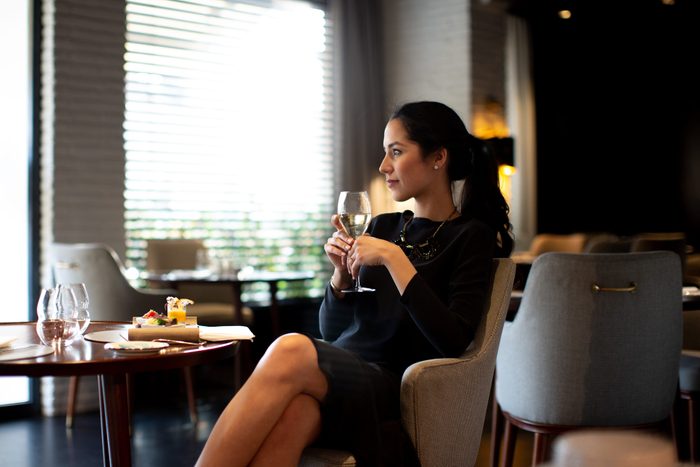
Drinking in your own honor
The most common mistake people make during a toast is drinking when the toast is proposed in their honor, Parker says. Don’t drink to yourself; simply allow your friends to honor you and graciously accept it, she says. Check yourself: Are you guilty of any of these 6 majorly annoying eating habits?
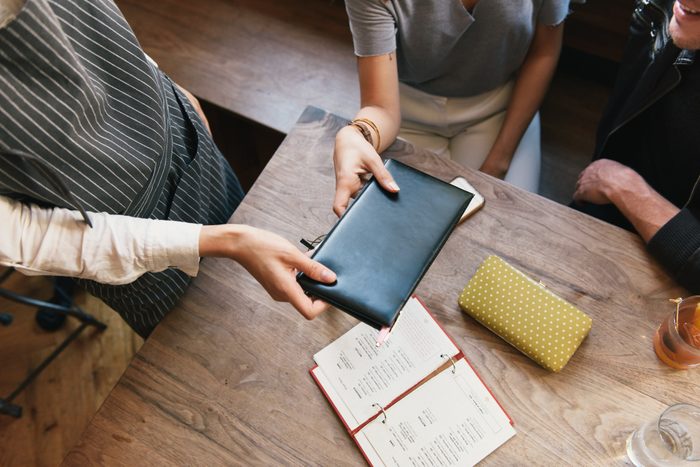
Waiting for the server to read your mind about the check
When the time comes to pay, your server will be looking to you for clues that you’re ready. They don’t want to rush you by asking if you’re ready but they also don’t want to keep you sitting if you’re ready to leave so it’s important to make it obvious when you’re ready to pay, Kalk says. “If you’re not ready to pay, leave the check presenter unmoved from where it was placed. If you are ready to pay, place the check presenter standing up with payment inside or leave it on the table with a bit of your credit card or cash sticking out so it’s easily visible,” she says.
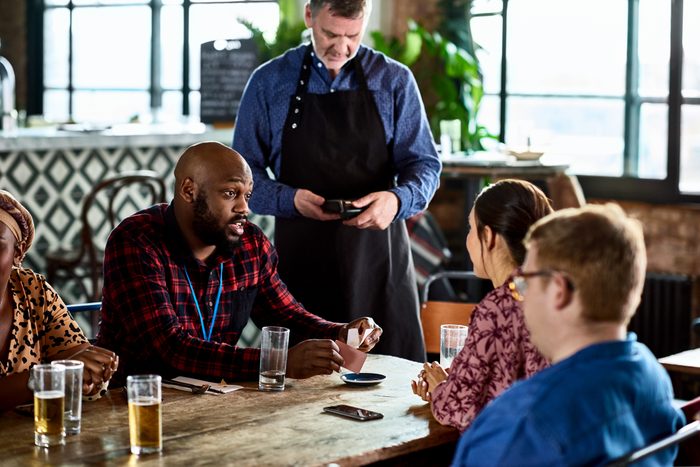
Arguing over who will pay
A little bit of polite banter between friends about who’s picking up the check is fine but generally, you should know who is going to be paying for whom before eating, Czink says. This is especially true if you are the host, she says. “If you know that you are paying, prearrange with the staff that the bill does not even come to your table,” she says. “That’s the most elegant solution.” Don’t want to cover the whole tab? Here are the right etiquette rules for paying a restaurant bill.

Taking your frustrations out on your waiter
“Being rude to the waitstaff is never, ever OK,” Parker says. The waiter is your point of contact with the restaurant and should be working to make your experience as pleasant as possible, but even if they’re not doing the best job, you still need to treat them as human beings, with kindness and patience. It doesn’t mean settling for bad service; it means being a good human. “There are ways to resolve complaints without being insulting, rude, or condescending to your waiter,” she says. Learn why chefs won’t order these foods in restaurants to avoid a bad meal.

Bringing up provocative conversation topics
Some people think polite conversation has to be boring conversation while others just seem to enjoy the drama of raised voices and drinks thrown in faces. “But this is not the type of excitement you want to bring to your meal, particularly if you’re eating in a restaurant,” Parker says. Be aware of the feelings of those you are dining with and of other people within earshot of you and keep your conversations appropriate, she says.
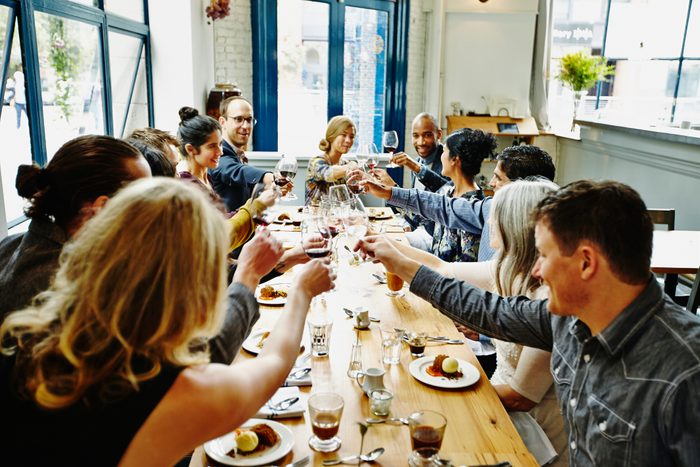
Using your outdoor voice
“An extra-loud person can ruin the meal not just for their dining companions but also for everyone in the dining area,” Parker says. Just like your teacher used to tell you, use your indoor voice indoors. Don’t miss these dirty secrets from kitchen crew employees.

Men wearing baseball caps indoors
“Men: It may seem like an old-fashioned double standard but it’s still considered good manners for you to remove hats indoors—and that includes casual toppers like ball caps,” Parker says. If you’re at a very casual dining venue, then it may be fine to leave it on; for most places, however, take it off. Make sure you know these 50 little tips for good manners.
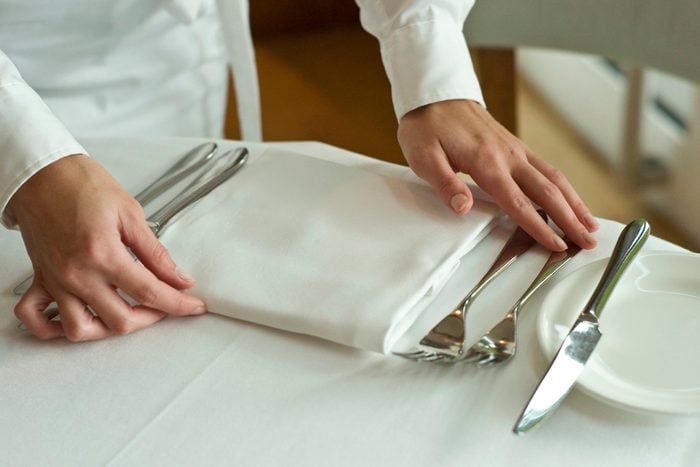
Being the etiquette police
“When you notice someone breaching etiquette at a restaurant it can be oh so tempting to call them out on it. Don’t,” Czink says. “Pointing out somebody’s mistake is worse than committing the faux pas yourself,” she says. If you’re concerned about teaching a child or a colleague you’re mentoring, then tell them their mistake in private, later.
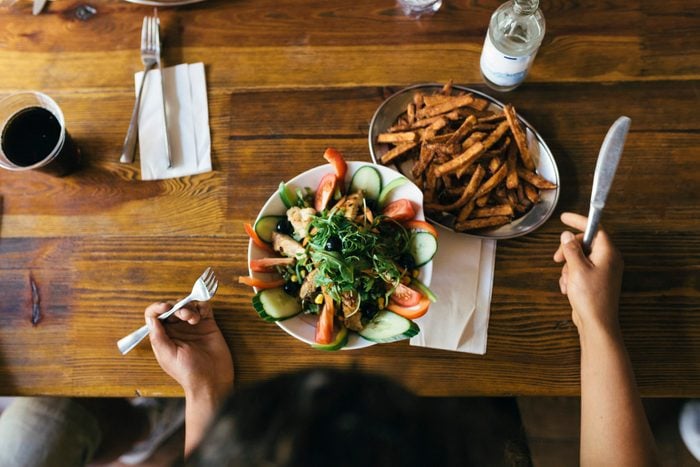
Eating before everyone is served
“Beginning to eat before everyone else is served is extremely rude,” Parker says. It’s a long-standing rule that you should wait for everyone to have their food in front of them before digging in. In an ideal situation, the kitchen would prepare all the dishes to be ready at the same time. Unfortunately, this doesn’t always happen. But if some people are served and others are still waiting, and they give you permission to eat, it’s fine to go ahead, she says. Luckily, it’s perfectly fine to loosen up and ignore these outdated etiquette rules even experts don’t follow.
Sources
- Maryanne Parker, Manor of Manners
- Leslie Kalk, Restaurant Coach
- Adeodata Czink, Business of Manners

